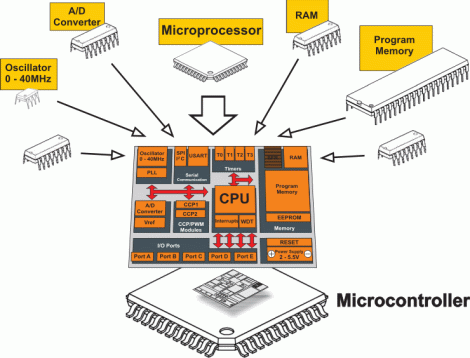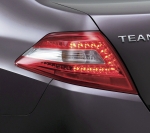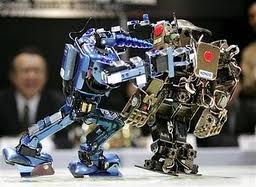
Microcontrollers vs Microprocessors
Dear readers, please note that this is the old website of maxEmbedded. The articles are now no longer supported, updated and maintained. Please visit the new website here and search for this post. Alternatively, you can remove .wordpress from the address bar to reach the new location.
Example: If the website address is http://maxEmbedded.wordpress.com/contact/, then removing .wordpress from it will become http://maxEmbedded.com/contact/.
We apologize for the inconvenience. We just want to give you a better viewing and learning experience! Thanks!
A microcontroller (sometimes abbreviated µC, uC or MCU) is a small computer on a single integrated circuit containing a processor core, memory, and programmable input/output peripherals.
A microprocessor (sometimes abbreviated µP, uP or MPU) incorporates the functions of a computer’s central processing unit (CPU) on a single integrated circuit (IC, or microchip).
Well, confused? In simple words, microcontroller is a full fledged PC in a single chip! On the other hand, microprocessor is the CPU of the PC in a single chip!
Okay, if someone asks you the configuration of your PC/laptop, how are you gonna tell them? Something like this (well, these are the configurations of my laptop… I know that it’s outdated and obsolete now, but it still serves my purpose 😉 )
- Intel core2duo T6600 processor
- 2.2GHz processing speed
- 2 MB cache
- 320 GB 7200 rpm hard disk
- 4 GB DDR2 RAM
- 512 MB dedicated ATI graphics card
- 15” WLED screen with HD 720p resolution
- and other stuffs
So, these are configurations of a full fledged laptop/PC. Now, a MCU has all these things! Surprised? Well, you must be wondering that earlier I said that MCU is a single chip, but laptop is such a huge thing. It contains so many chips, so many devices, peripherals, etc. How can a MCU accommodate all these? Well, it has all these features, but on a lower/limited/restricted scale. Let’s take an Atmel ATMEGA32 MCU. It has the following specifications:
- 32 KB Flash memory
- 2 KB RAM
- 1 KB EEPROM
- 16MHz maximum speed
- 40 pin IC
- and many others that we will come across later
So, you see, a small IC can easily accommodate these features. You can consider microprocessor to be built up of separate units, but having higher resources.
In simplest terms,
MPU = CPU
MCU = MPU + Peripherals + Memory
Peripherals = Ports + Clock + Timers + UART/USART + ADC + DAC + LCD Drivers + Other Stuffs
Memory = Flash + SRAM + EPROM + EEPROM
(Don’t worry about these terms, we will discuss them when needed)
Since a PC has higher resources (from higher resources, I mean 4GHz processor instead of a 16MHz one, 4GB RAM instead of a 2KB RAM, etc), it is difficult to squeeze them into a single IC, thus we have separated units.
Thus it’s all about putting more in small space. As the technology gets improved, more stuffs can be squeezed into a single IC. It all depends upon the latest VLSI Design technology.
The following diagram explains it all!
Now you must be thinking that if a MCU is a PC, then why use use MPU? At this point, I would like to bring up the following point. A MCU is usually application specific or in other words, specific to applications that don’t require higher resources. For example, in a LED lighting system. Here, its absolutely worthless to implement a 2.2GHz core2duo processor, 320GB HDD, 4GB RAM, etc. A 16MHz single core processor, 16KB Flash, 1KB RAM, etc is more than enough for this application. So why waste money and resources on a MPU when we can manage it easily with a low cost MCU? But in case of a MPU, it can handle huge loads and features multitasking. You can play games in your PC, as well as browse the internet from the same PC.
Thus, we have discussed another important point that microcontrollers are usually designed to perform a small set of specific functions, for example as in the case of a Digital Signal Processor (like TMS320 by Texas Instruments) which performs a small set of signal processing functions, whereas microprocessors tend to be designed to perform a wider set of general purpose functions.
For those whom it might concern, the most MPUs are based upon von Neumann architecture (same memory is for both, program and data) whereas most MCUs are based upon Harvard architecture (separate memories for program and data). However, exceptions do exist!
Examples of MPU include the Intel processors (Pentium series, Dual Core, Core i7, etc), AMD processors, etc and examples of MCU include those made by Atmel (AVR), Microchip (PIC), Intel (8051), Texas Instruments (MSP430), etc.
Let’s have a look at few more microcontroller applications:
- alarm clocks, electric toothbrush
- microwave ovens, automatic electric heaters
- traffic signals
- phones and mobile phones
- automotive – lighting, braking, speed control
- harddisks, pendrives, printers, mouse, cameras, small electronic machines
- day to day applications like washing machines, photocoping machine, elevators, etc
- life saving equipments like pacemaker, etc
- and the list is endless!
Hence, we conclude that our world is too much wired, and too much full of microcontrollers! Try spending a day without microcontrollers… I bet you can’t! And if you do, kindly share your experiences with me 😉
And don’t forget to leave a reply below and tell me how did you like this article!
Summary
- MPU = CPU (single chip)
- MCU = MPU + Peripherals + Memory (single chip)
- MCUs are application specific whereas MPUs are designed for varied applications
- MPUs and MCUs have different architectures
- Life is incomplete without MCUs!




i just started, quite interesting.
Good! I’m sure you’ll love it! 🙂
Nice nd easily understandable :-).which college year?
Thank you Anchal! Happy learning! 🙂
very informative and basic, excellent. Thanks.
Thanks Syed. 🙂
good tutorial for beginners .. important points with much simplicity .. Good work ..
Thanks Akhil.
It is very good & useful article.. thanks
Thank you Pooja.